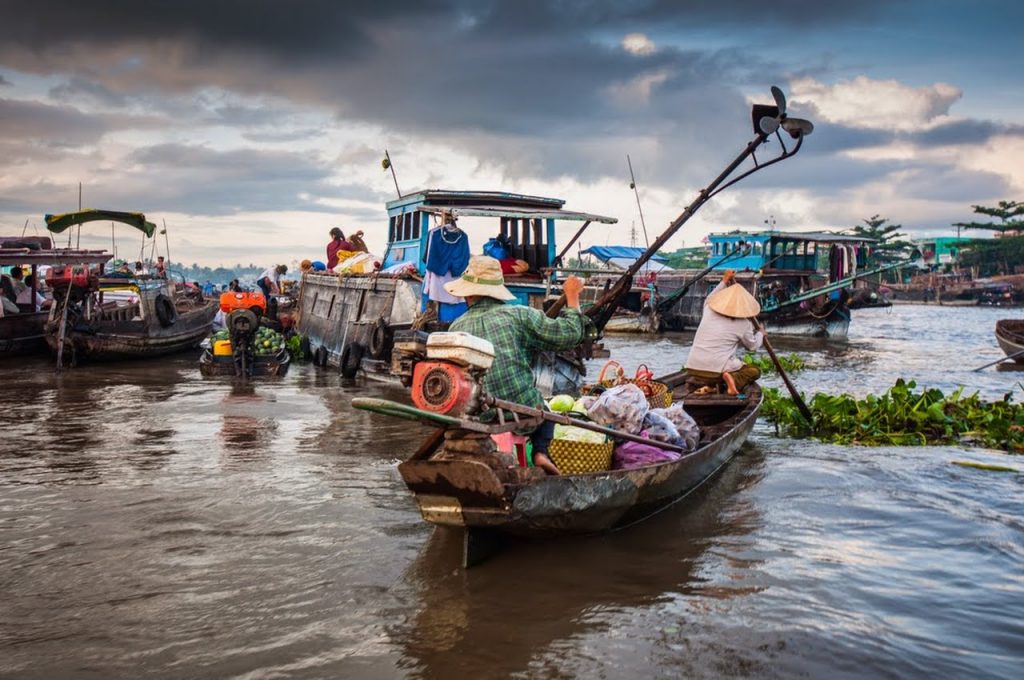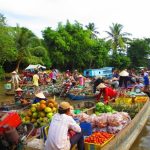8 best ways to experience Mekong River Delta in Vietnam
Spread across 39,000 square kilometres in Vietnam’s southwest, the Mekong Delta is a world unto itself. It’s lush agricultural lands, dissected by countless waterways, serve as the rice bowl of the country, and traditional villages where life moves along at a sleepy pace dot the region. The rivers and canals serve as the primary means of transport and trade, with floating markets and French colonial port towns busy with the comings and goings of daily life. The region also boasts an incredible biological diversity, with protected forests housing an impressive bird life and offshore islands surrounded by coral reefs teeming with marine life. From taking in tranquil scenes of farmers wading buffalo through the floodplains to participating in the local festivities, here are eight ways to experience Mekong River Delta offers.
1. Day trip to My Tho from Ho Chi Minh City

Undoubtedly one of the most popular ways to visit the delta is on a day trip from Ho Chi Minh City. The town of My Tho serves as the launching point for boat trips into the delta to visit nearby islands and local agricultural industries, such as rice and banana cultivation. Wander the backstreets of this bustling market town, founded in the 1680s by Chinese refugees and once home to a French garrison, and watch the river traffic come and go from Lac Hong Park. Don’t miss a visit to the magnificent Vinh Trang Temple in the nearby village, built in the mid 19th century and surrounded by fruit trees. While it’s not possible to do this stunning region justice in a day or venture deep into the delta’s heart, My Tho does offer a glimpse of life along the Tien Giang River, the Delta’s most northern tributary.
2. Visit the fruit orchards of Ben Tre province

Situated in the lowest part of the Mekong River Basin, Ben Tre province is famed for its abundance of fruit orchards and breathtaking scenery. If you wanna find peaceful place, you should experience Mekong River Delta. It is comprised of three islands set between three rivers which splinter from the Mekong River, and its skyline is dominated by towering coconut palms. In addition to providing the base for Ben Tre’s famous coconut desserts and candy, coconut oil is produced along with coconut-carved lamps, dolls and baskets in the region. More than 40,000 hectares of Ben Tre are dedicated to fruit production, including a number of special varieties, such as stone-free durian, green-skinned pomelo and the Four Season mango. Take a boat trip to explore Ben Tre’s agricultural bounty, visit the local museum to soak up the area’s history and explore the lively market to sample its famed produce.
3. Go bird watching in Cao Lanh

For ‘twitchers’ the waterways and swamplands surrounding Cao Lanh are an essential excursion if you are visiting the delta, where elegant storks and cranes wade through the shallow waters. Both Tram Chim and Ca Mau National Parks can easily be explored by boat. Here Egrets, Kingfishers and Eastern Sarus Crane are often spotted, together with song birds such as Reed-warblers, Pied Fantails and Asian Golden Weavers. Experienced guides are on hand to help you find both resident and migratory species including a few rarities, so don’t forget to pack your binoculars!
4. Witness the colorful flower gardens of Sa Dec

The sleepy town of Sa Dec is one of the Mekong Delta’s relatively undiscovered gems, set along a busy stretch of the Mekong River. It is famed not only as the setting of Marguerite Duras’ autobiography ‘The Lover’, but also for its beautiful flower gardens that bathe the region in colour. The French colonial architecture of Sa Dec has been charmingly preserved in old riverside mansions and merchant houses. Take a walk along the riverfront road of Nguyen Hue, lined with cafes perfect for people watching, and visit the impressive Kien An Chung pagoda in the centre of the town. To see the delta’s produce on vivid display, don’t miss a wander through Sa Dec’s authentic old market.
5. Visit the floating markets surrounding Can Tho

Can Tho is the economic, political and cultural hub of the Mekong Delta, whose wide boulevards and bustling waterfront are the centre of trade in the region. While the city itself is a great place to explore, the main draw is the surrounding floating markets, set within the rivers and canals that disperse from its outskirts. Small boats offering a dizzying array of goods, snacks and fresh produce ply the waters and, unlike other floating markets throughout Southeast Asian countries, the trade here is authentic. The photographic opportunities are fantastic and with roads springing up throughout the region, the future of the floating markets and the chance to witness them in the Mekong Delta may be limited.
6. Witness the colourful Oc Om Bok festival in Soc Trang
If you are visiting the Mekong Delta in November or December at the start of the dry season, then head to the Khmer town of Soc Trang. Here on the 14th or 15th day of the tenth lunar month, the annual Oc Om Bok Festival sees the local community take to the water for longboat races along the Maspero River. The festival celebrates the Khmer moon deity, and offerings of fruit, rice and cake are proffered at pagodas by traditionally dressed villagers, along with prayers for good rice harvests, luck and happiness in the future. One of the most magnificent sights during the festival is the release of floating lights along the river, believed to rid the village of darkness, impurity and sadness.
7. Climb Sam Mountain from Chau Doc

Just to the west of Chau Doc, near the Cambodian border, the flat plains are broken by the 230 metre high Sam Mountain. Walks to its peak offer beautiful views across the surrounding landscape and its slopes are dotted with pagodas and temples of Chinese influence, some of which are nestled into caves. It is a popular pilgrimage site for locals and foreigners of Chinese descent who come to pay their respects at the mountain top shrine. Here a military outpost also stands from the days when the Khmer Rouge threatened across the border, guarded by amiable soldiers who have become accustomed to having their photographs taken with inquisitive tourists. In the region surrounding Sam Mountain don’t miss a visit to the Tay An Pagoda or Ba Chua Xu Temple, as well as the beautiful Tao Ngo Gardens.
8. Relax at the tropical paradise of Phu Quoc Island

The quiet Mekong Delta fishing port of Ha Tien serves as the launching point for trips to the tropical paradise of Phu Quoc Island. Situated within the Gulf of Thailand, just offshore from southern Cambodia, Phu Quoc is still relatively undeveloped, despite being Vietnam’s largest island, and offers the perfect barefoot bliss escape. It once served as an island prison camp and today is home to just a scattering of resorts set along stunning stretches of pristine white beach, backed by coconut palms. Hike through Phu Quoc’s protected inland forests and explore its secluded coves, lapped by turquoise waters, then head underwater to dive or snorkel its rich coral reefs, home to an abundant marine life.
The uncertain future of the Mekong Delta
The rustic scenes of daily life set against a spectacular rural backdrop make the Mekong Delta one of Vietnam’s most appealing destinations. Travelling along the placid waterways, past beautiful agricultural landscapes, stilt houses and floating markets, offers not only a deep insight into local life, but also fantastic photographic opportunities. While the regions closest to Ho Chi Minh City see a steady stream of tourists, head deeper and you will find little-visited towns and villages where welcoming locals await. The Mekong Delta’s low lying position has made it susceptible to the drastic impacts of climate change and, in particular, sea level rise. With some scientists predicting that many regions within the delta will be completely flooded by 2030, the time to see this spectacular part of Vietnam is now.

















